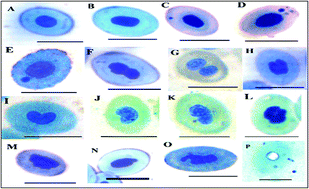Ultraviolet A-induced hematotoxic and genotoxic potential in Nile tilapia Oreochromis niloticus
Abstract
Fish as an aquatic organism could be harmed by various levels of solar ultraviolet radiation (UVA). The present study aimed to characterize UVA (20, 60 and 180 min for 3 days) irradiation-induced hematological and biochemical changes in Oreochromis niloticus. Hematological parameters such as the red blood cell (RBC) count, hemoglobin (Hb) level and hematocrit (Hct) value were significantly (p < 0.05) reduced in fish exposed to different doses of UVA. Also, the leukocyte (WBC) count was significantly reduced (p < 0.05). However, the differential counts of WBCs – lymphocytes, eosinophils and monocytes – increased significantly in the exposed fish compared to the control fish. Many morphological and genotoxic alterations in erythrocytes were observed in the present work. The glucose level showed a significant decrease, but cholesterol and triglycerides showed a significant increase after exposure to UVA. Total protein levels of the fish showed a significant increase (p < 0.05) in the exposed groups. Also, concentrations of urea and creatinine increased significantly as fish were exposed to increasing UVA radiation, compared to the control fish. Finally, the activities of alanine aminotransferase (ALT, U l−1) and aspartate aminotransferase (AST, U l−1) exhibited a significant increase (p < 0.05) with increasing UVA doses.



 Please wait while we load your content...
Please wait while we load your content...